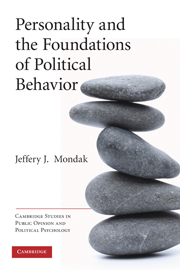Book contents
- Frontmatter
- Contents
- List of Figures
- List of Tables
- Acknowledgments
- Personality and the Foundations of Political Behavior
- 1 Personality and Politics
- 2 The Big Five Approach
- 3 Measuring the Big Five
- 4 Personality and Political Information
- 5 Personality, Attitudes, and Political Predispositions
- 6 Personality and Political Participation
- 7 The Multiple Bases of Political Behavior
- References
- Index
- Titles in the series
- References
References
Published online by Cambridge University Press: 05 June 2012
- Frontmatter
- Contents
- List of Figures
- List of Tables
- Acknowledgments
- Personality and the Foundations of Political Behavior
- 1 Personality and Politics
- 2 The Big Five Approach
- 3 Measuring the Big Five
- 4 Personality and Political Information
- 5 Personality, Attitudes, and Political Predispositions
- 6 Personality and Political Participation
- 7 The Multiple Bases of Political Behavior
- References
- Index
- Titles in the series
- References
- Type
- Chapter
- Information
- Personality and the Foundations of Political Behavior , pp. 197 - 218Publisher: Cambridge University PressPrint publication year: 2010



